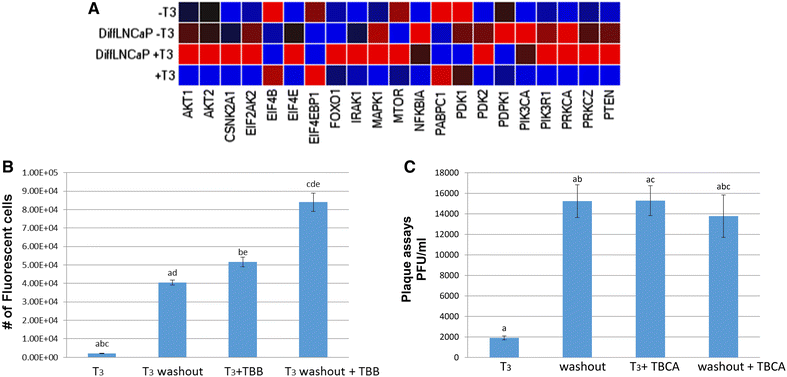New insights on thyroid hormone mediated regulation of herpesvirus infections
- PMID: 28344765
- PMCID: PMC5360088
- DOI: 10.1186/s13578-017-0140-z
New insights on thyroid hormone mediated regulation of herpesvirus infections
Abstract
Thyroid hormone (T3) has been suggested to participate in the regulation of herpesvirus replication during reactivation. Clinical observations and in vivo experiments suggest that T3 are involved in the suppression of herpes virus replication. In vitro, differentiated LNCaP cells, a human neuron-like cells, further resisted HSV-1 replication upon addition of T3. Previous studies indicate that T3 controlled the expression of several key viral genes via its nuclear receptors in differentiated LNCaP cells. Additional observation showed that differentiated LNCaP cells have active PI3K signaling and inhibitor LY294002 can reverse T3-mediated repression of viral replication. Active PI3K signaling has been linked to HSV-1 latency in neurons. The hypothesis is that, in addition to repressing viral gene transcription at the nuclear level, T3 may influence PI3K signaling to control HSV-1 replication in human neuron-like cells. We review the genomic and non-genomic regulatory roles of T3 by examining the phosphoinositide 3-kinase (PI3K) pathway gene expression profile changes in differentiated LNCaP cells under the influence of hormone. The results indicated that 15 genes were down-regulated and 22 genes were up-regulated in T3-treated differentiated LNCaP cells in comparison to undifferentiated state. Of all these genes, casein kinase 2 (CK2), a key component to enhance PI3K signaling pathway, was significantly increased upon T3 treatment only while the cells were differentiated. Further studies revealed that CK2 inhibitors tetrabrominated cinnamic acid (TBCA) and 4, 5, 6, 7-tetrabromo-2H-benzotriazole (TBB) both reversed the T3-mediated repression of viral replication. Together these observations suggested a new approach to understanding the roles of T3 in the complicated regulation of HSV-1 replication during latency and reactivation.
Keywords: 2-Morpholin-4-yl-8-phenylchromen-4-one; 4,5,6,7-Tetrabromo-2H-benzotriazole; Casein kinase 2; Differentiation; Herpes simplex virus; Phosphoinositide 3-kinase; Tetrabrominated cinnamic acid; Thyroid hormone.
Figures


Similar articles
-
Thyroid hormone-dependent epigenetic suppression of herpes simplex virus-1 gene expression and viral replication in differentiated neuroendocrine cells.J Neurol Sci. 2014 Nov 15;346(1-2):164-73. doi: 10.1016/j.jns.2014.08.017. Epub 2014 Aug 20. J Neurol Sci. 2014. PMID: 25175854 Free PMC article.
-
Overexpression of thyroid hormone receptor β1 altered thyroid hormone-mediated regulation of herpes simplex virus-1 replication in differentiated cells.J Neurovirol. 2016 Oct;22(5):555-563. doi: 10.1007/s13365-016-0423-x. Epub 2016 Feb 3. J Neurovirol. 2016. PMID: 26843385 Free PMC article.
-
A Novel Thyroid Hormone Mediated Regulation of HSV-1 Gene Expression and Replication is Specific to Neuronal Cells and Associated with Disruption of Chromatin Condensation.SOJ Pharm Pharm Sci. 2014;1(1):06. doi: 10.15226/2374-6866/1/1/00106. SOJ Pharm Pharm Sci. 2014. PMID: 25346944 Free PMC article.
-
Disturbed Yin-Yang balance: stress increases the susceptibility to primary and recurrent infections of herpes simplex virus type 1.Acta Pharm Sin B. 2020 Mar;10(3):383-398. doi: 10.1016/j.apsb.2019.06.005. Epub 2019 Jun 22. Acta Pharm Sin B. 2020. PMID: 32140387 Free PMC article. Review.
-
A comparison of herpes simplex virus type 1 and varicella-zoster virus latency and reactivation.J Gen Virol. 2015 Jul;96(Pt 7):1581-602. doi: 10.1099/vir.0.000128. Epub 2015 Mar 20. J Gen Virol. 2015. PMID: 25794504 Free PMC article. Review.
Cited by
-
Identification of the Hub Genes Involved in Chikungunya Viral Infection.Cureus. 2024 Apr 4;16(4):e57603. doi: 10.7759/cureus.57603. eCollection 2024 Apr. Cureus. 2024. PMID: 38707036 Free PMC article.
-
Thyroid hormone activates Xenopus MBD3 gene via an intronic TRE in vivo.Front Biosci (Landmark Ed). 2020 Jan 1;25(3):437-451. doi: 10.2741/4812. Front Biosci (Landmark Ed). 2020. PMID: 31585895 Free PMC article.
-
Artificial intelligence defines protein-based classification of thyroid nodules.Cell Discov. 2022 Sep 6;8(1):85. doi: 10.1038/s41421-022-00442-x. Cell Discov. 2022. PMID: 36068205 Free PMC article.
-
The expanding functions of thyroid hormone.Cell Biosci. 2017 Oct 19;7:53. doi: 10.1186/s13578-017-0176-0. eCollection 2017. Cell Biosci. 2017. PMID: 29075436 Free PMC article. No abstract available.
-
Herpes zoster ophthalmicus with ocular involvement in overtreated hyperthyroidism.Indian J Ophthalmol. 2020 Jul;68(7):1457-1458. doi: 10.4103/ijo.IJO_1759_19. Indian J Ophthalmol. 2020. PMID: 32587196 Free PMC article.
References
Publication types
Grants and funding
LinkOut - more resources
Full Text Sources
Other Literature Sources

